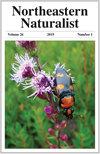首个白尾鹿捕食盐沼麻雀巢穴的记录
IF 0.5
4区 环境科学与生态学
Q4 BIODIVERSITY CONSERVATION
引用次数: 1
摘要
摘要:盐沼麻雀(Ammospiza caudacuta)是盐沼筑巢的专性物种,由于种群数量减少和未来可能面临的威胁,如气候变化引起的海平面上升,因此受到最大的保护关注。由于洪水、栖息地丧失和捕食,繁殖成功率低是限制该物种种群增长的一个因素。为了进一步了解捕食对筑巢的盐沼麻雀的影响,我们在2022年繁殖期间在佛罗里达州沃伦的雅各布角盐沼的监测巢穴中部署了相机陷阱。在观察到的2个筑巢失败的例子中,摄像机捕捉到了白尾鹿(Odocoileus virginianus)对卵的明显掠夺。我们认为这是第一个记录在案的白尾鹿捕食盐沼麻雀巢穴的案例。这一发现对盐沼麻雀的保护和未来旨在提高繁殖成功率的管理策略具有重要意义。本文章由计算机程序翻译,如有差异,请以英文原文为准。
First Record of White-Tailed Deer Depredating Saltmarsh Sparrow Nests
Abstract - Ammospiza caudacuta (Saltmarsh Sparrow) is a salt marsh-nesting obligate species of greatest conservation concern due to decreasing populations and probable future threats, such as climate change-induced sea-level rise. Low reproductive success is a limiting factor to population growth for the species due to flooding, habitat loss, and predation. To further understand the effects of predation on nesting Saltmarsh Sparrows, we deployed camera traps at monitored nests in Jacob's Point salt marsh, Warren, RI, during the 2022 breeding period. In 2 instances of observed nest failure, camera traps captured the apparent depredation of eggs by Odocoileus virginianus (White-tailed Deer). We believe these to be the first documented cases of Saltmarsh Sparrow nest predation by White-tailed Deer. This finding has implications for the conservation of Saltmarsh Sparrows and for future management strategies aimed at increasing breeding success.
求助全文
通过发布文献求助,成功后即可免费获取论文全文。
去求助
来源期刊

Northeastern Naturalist
环境科学-生态学
CiteScore
1.10
自引率
0.00%
发文量
42
审稿时长
18-36 weeks
期刊介绍:
The Northeastern Naturalist covers all aspects of the natural history sciences of terrestrial, freshwater, and marine organisms and the environments of the northeastern portion of North America, roughly bounded from Virginia to Missouri, north to Minnesota and Nunavut, east to Newfoundland, and south back to Virginia. Manuscripts based on field studies outside of this region that provide information on species within this region may be considered at the Editor’s discretion.
The journal welcomes manuscripts based on observations and research focused on the biology of terrestrial, freshwater, and marine organisms and communities as it relates to their life histories and their function within, use of, and adaptation to the environment and the habitats in which they are found, as well as on the ecology and conservation of species and habitats. Such studies may encompass measurements, surveys, and/or experiments in the field, under lab conditions, or utilizing museum and herbarium specimens. Subject areas include, but are not limited to, anatomy, behavior, biogeography, biology, conservation, evolution, ecology, genetics, parasitology, physiology, population biology, and taxonomy. Strict lab, modeling, and simulation studies on natural history aspects of the region, without any field component, will be considered for publication as long as the research has direct and clear significance to field naturalists and the manuscript discusses these implications.
 求助内容:
求助内容: 应助结果提醒方式:
应助结果提醒方式:


